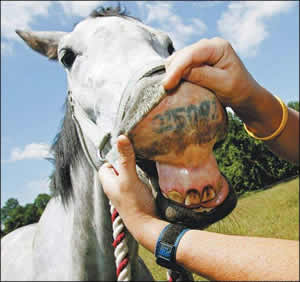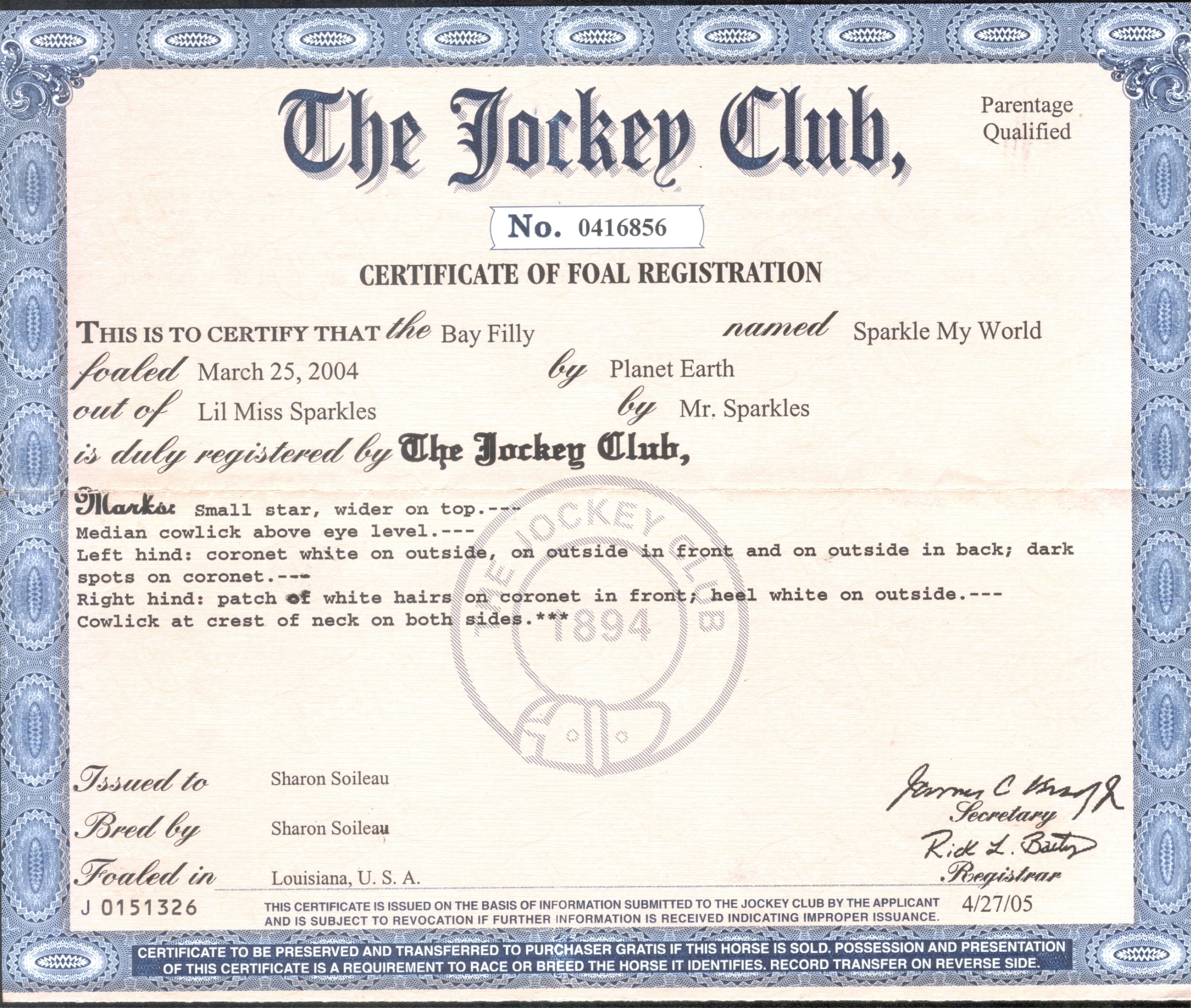Horse racing has been around a long time with each state having its own racing commission that establishes and governs the rules and regulations for that particular state. Racing commission officials are appointed positions. The commissions require trainers to abide by certain procedures for preparing a horse for its first race; making entries, scratching, or withdrawing a horse from a race; and even gaining entry to the stable area.
I cannot count the number of times that someone has assumed that I just wake up on a Saturday morning and say "I think I'll race a horse today," and then go snatch one up from the pasture and head off to the races. First and foremost, the horse is an athlete and must be fed and conditioned accordingly. This cannot be done if the horse lives in a pasture.
Secondly, race entries must be made within a specific time frame, usually 72 hours in advance. This affords officials sufficient time to set the field, and once the races are "drawn" (i.e. set), the list of entries is sent to the printer so that race day programs and past performances can be printed and made available to the public.
Now for the specifics...
Before a horse can run in its first race, it must be tattooed for identification purposes. The tattoo is placed inside the horse's upper lip (See Below).
For thoroughbreds, the tattoo is comprised of 6 characters - one letter in the beginning signifying the year of foaling, followed by 5 numbers from the horse's official registration number. The Jockey Club, which is the official registry for thoroughbreds, assigns each horse a letter of the alphabet corresponding to the year the horse was born. This registration process began in 1971 with the letter "A", continued all the way through "Z", and then started over again with "A" in 1997.
The official registration number contained at the top of the registration certificate is actually 7 numbers long - a two-digit birth year number and a five-digit "VIN" number of sorts (the latter which appears in the tattoo). The letter that appears in the tattoo, which represents the year the horse was born, is switched to a two-digit number on the racing certificate (e.g. an "A" for a horse foaled in 1997 becomes "97"). There simply isn't enough room inside the horse's lip for more than 6 total characters. The reason there is a five-digit "VIN" identification number is that there are approximately 35,000 thoroughbred foals registered in North America each year.
The registration certificate is similar to a birth certificate and title combined. In addition to containing a registration number at the top, it contains the horse's official name, its parents' names (i.e. Planet Earth (sire/father) and Lil Miss Sparkles (dam/mother)), the sire of the horse's dam (i.e. Mr. Sparkles), date of birth, state where it was foaled, its markings, and the owner of the dam, which is me. The registration process requires the horse owner or registrant to submit five color photos of the foal; a stallion service certificate; six prospective names for the horse to be considered by The Jockey Club; a detailed description of the horse's markings, including cowlicks/swirls (which is a lock or tuft of hair growing in a different direction from the rest of the hair, usually in a circular pattern; all horses have at least one on each side of their neck and one or two on their face); a hair sample of the foal for DNA testing; and a check for $200.00.
When a horse is taken before the official identifier, who is an individual approved and appointed by The Jockey Club, the horse's markings, including all cowlicks, must match the registration certificate exactly. If not, the word "rejected" is stamped in big bold red letters on the front of the certificate. If this happens, new photos must be submitted with corrected markings to The Jockey Club, along with a correction fee. If everything is correct, the horse gets his tattoo, which is necessary for identification purposes when he goes to the starting gates for his approval to race. Also, every horse's tattoo is verified by the individual track's identifier before each and every race.
Now that the horse has received its tattoo and its "papers" (i.e. registration certificate), it is ready to go to the racing office for an entry date, provided that a current Coggins test has been conducted and the positive results are submitted. A Coggins test is a mandatory blood test that is performed annually by a state certified laboratory to test for Equine Infectious Anemia ("EIA"), or better known as Swamp Fever. EIA is a disease that is carried from horse to horse by mosquitoes that causes fever, depression, and death. There is no cure or vaccine available, and any horse that tests positive for Swamp Fever, is required by law to be euthanized.
Every track operates on a "date" system to determine the priority by which horses are selected to enter a particular race. The date system is set up so that everyone has an equal opportunity to race. Everyone starts with the same entry date. Each time a horse runs, he receives a new entry date corresponding with the date of his last race, which puts him behind the other horses who have not run yet in terms of priority. The earliest entry date gets preference to "draw" into a race. If there was no date system, all horses would be drawn at random and the lucky guy would get to run often, while the unlucky guy might never get to run.
Let's take a look at the specifics of the "date" system and how entry dates actually work. At the beginning of a given meet, all papers turned into the racing office by a specified day receive a "zero" date, which is the earliest possible date. Every time a horse competes in a race, his date is changed from "0" to "R", and he receives a new date corresponding to the date of the race. If he draws into a race and is scratched, the horse gets an "S" date. When the papers are submitted to the racing secretary after the deadline expires for the "0" date, he receives an "E" date. A super dates is a date given to all horses scheduled to race on a day in which the races were canceled for any reason and it is denoted by an '*'. Super dates, along with zero dates, are given first preference. An "E" date would supersede an "R" date, and both of these have priority over an "S" date. If three horses have a 6/10/2009 race date and one has an "E", one has an "R", and one has an "S", upon entering the same race, the "E" "draws" into the race first, followed by the horse assigned an "R", and ending with the "S" date.
Once the horse has received his entry date, now he must go through a series of official workouts to obtain his gate card and an official start. These official workouts are known as published works (or breezes). A published work is when a horse runs a specified distance at full speed and it is timed and recorded. It is designed to let the public and racing officials know that the horse is fit to race.
Tracks have a published works requirement for all horses, but especially stringent ones for first time starters (a horse that has yet to compete in his racing debut). All tracks require first time starters to have several published works (usually at least 3). Tracks take these requirements very seriously and fines are levied against trainers who fail to comply.
To receive a published work, the rider must report the horse's name and the distance to be worked to the official clocker when the horse enters the track, so that his works can be recorded. He must also be approved from the starting gates by the starter - the person who opens the gates to begin a race. Once the horse has proven that he will load, stand quietly, break alertly, and run straight, the starter will fill out an "okay" card with the horse's name, age, equipment, the trainer's name, the date the horse was approved, and put it on file in the racing office. Some tracks require first time starters to participate in "schooling" races before they actually run in a sanctioned race. Schooling races are held either late morning or early afternoon on a non-race day. They will consist of 8 to 10 horses in a mock race with no purse money or wagering allowed.
Trainers can and often obtain their horse's entry date before getting published works. This way, when the horse is ready to run, they will already have a "zero" date, and won't have to wait a couple of weeks before "drawing" into a race.
Finally, the horse has his okay to run in a race. Now the trainer will look through his "condition book" to select an appropriate race. The condition book is a list of upcoming races, usually for two weeks at a time. Once the trainer has selected a race that he wishes to put the horse in, he will have to enter the horse. Entries are taken several days in advance and only from 8:00 to 10:00 am. Once entries are closed, office personnel will check all entries for that day to make sure that each horse is eligible for the race in which it was entered, the Coggins test is current, and first timers have met their published works requirements.
Since there is often more entries in a single race than there are spots in the starting gates, the horses with the earliest entry dates will be selected. At the "draw", which is performed by the racing secretary and usually one horseman, all of the horses' names for a particular race will be placed on "entry" cards and placed in a specially designed wooden box. The horseman will have a bottle, shaped like a soda bottle, which contains small individually numbered cubes, similar to dice. The horseman will shake one number out of the bottle and the racing secretary will pull out one entry card. The horse's name is called out and he is assigned the number that was just drawn. This will be his post position in the race. This procedure continues until all of the post positions are filled.
Horses that compete in races have additional guidelines related to racing etiquette that must be followed.
There is clearly a little more to racing than just getting a horse out of the pasture and going to the track.



TROUBLEMAKER
10-09-2010Racing officials at Rideau Carleton Raceway in Ontario,Canada say a horse's post position is chosen by a computer but this is perhaps a ploy to secretly discriminate against certain outsiders..THE FIX IS IN???
Comments Closed
Juliana Diaz
04-17-2012Agreed all the way until the part about not being able to raise an athlete in a pasture- that kind of thinking is what kills so many racehorses. It may not be practical for most people, but its what is best for the horse and racing should soon look in that direction.
Comments Closed